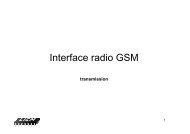Dependable Memory - Laboratoire Interface Capteurs ...
Dependable Memory - Laboratoire Interface Capteurs ...
Dependable Memory - Laboratoire Interface Capteurs ...
You also want an ePaper? Increase the reach of your titles
YUMPU automatically turns print PDFs into web optimized ePapers that Google loves.
8 GENERAL INTRODUCTION<br />
system boundaries to cause catastrophic failures 1 . Consequently, the hardware based concurrent<br />
error detection (CED) has been chosen. To limit the overall cost, we may accept little time penalty in<br />
error correction. In this scenario, the software based rollback is employed. It will reduce the overall<br />
cost as compared to hardware based recovery. Whereas, it will not effect lot to overall performance<br />
because the proposed methodology is suitable for ground applications where occurrence of error is<br />
far less than space.<br />
There is a hypothetical dependable memory (DM) attached to the processor. Moreover, to make<br />
the rollback fast and to simplify the memory management there is an intermediate data storage be-<br />
tween processor and DM. Here, architectural choices are important to make the overall methodology<br />
successful. For-example, the processor core having minimum internal states to be checked (for detect-<br />
ing error) and load and store (for rollback recovery) can make this technique effective (less expensive<br />
and fast). The FT processor has been modeled at VHDL-RTL level. Finally, the processor self check-<br />
ing ability and performance degradation due to re-execution has been tested by artificial error injection<br />
in the simulated model.<br />
The contributions of this work are as follows: Proposing a new methodology based on hard-<br />
ware/software co-design to have a compromise between protection and time/area constrains. For<br />
fast error detection, hardware based concurrent detection is employed. For low hardware overheads,<br />
software based micro-rollback recovery will be used. To reduce the overall area overheads we are em-<br />
ploying stack processor from MISC class. The processor has minimum internal registers which result<br />
in low cost error detection and on the other hand it is suitable for efficient error recovery. Further-<br />
more to mask the error from entering into DM, the intermediate temporal data storage is introduced<br />
between processor and DM.<br />
This thesis is partitioned into six chapters.<br />
Chapter 1: It outline the background and describe the motivation for on-line error detection and<br />
fast correction in embedded microprocessors. It present the basic concepts and the terminologies<br />
related to dependable embedded processor design. It further explores attributes, threats and means<br />
to attain dependability. Lastly, the different dependability techniques applied at different levels are<br />
discussed.<br />
Chapter 2: This chapter will be presenting different redundancy techniques to detect and correct<br />
errors. It explores different FT methodologies employed in the existing fault tolerant processors. The<br />
last part will be dedicated to the validation methodology of a dependable processor.<br />
Chapter 3: This chapter identifies the model specifications and design methodology of the desired<br />
architecture. It address the overall problem by exploring the design paradigm and the related con-<br />
strains of the proposed approach. Later the processor-memory interface will be finalized by different<br />
functional implementations.<br />
Chapter 4: The proposed FT processor has two parts: self-checking processor core (SCPC) and<br />
self-checking hardware journal (SCHJ). This chapter steps towards a design methodology of self-<br />
1 where the cost of harmful consequences is orders of magnitude, or even incommensurably, higher than the benefit<br />
provided by correct service delivery [LRL04]



